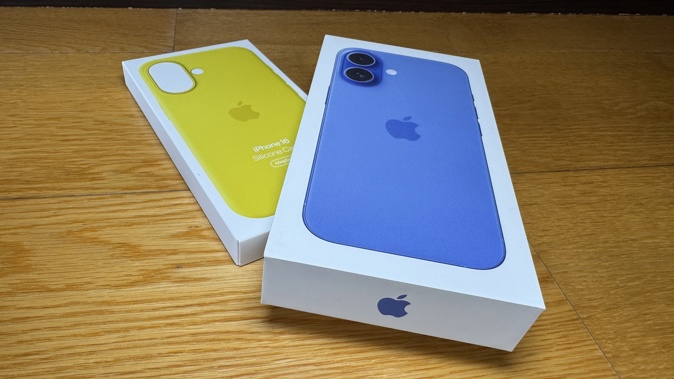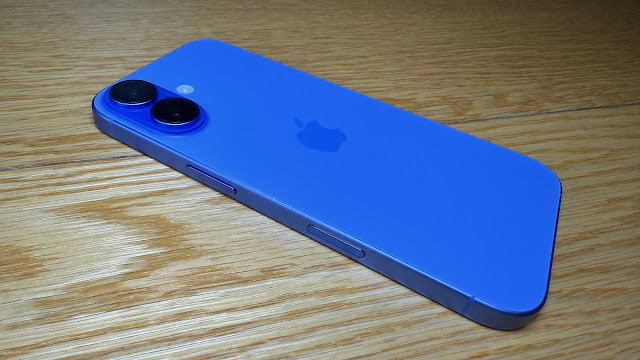
As I've already established when reviewing the iPhone 16 Pro Max a week or two ago, this year's iPhone launch revealed a surprising number of upgrades for the two non-Pro members of the line-up.
Some years I like to review the base iPhone first and work my way up to the Pro but other years it's fun to do it the other way around; use my phone like a pro for a few weeks then "downgrade" to see what exactly I'm missing out on at the lower price point.
This year, I've taken the second option and I tell you what, the differences are getting harder to spot.
Firstly, there are a couple of pretty obvious physical features that set the 6.1-inch iPhone 16 (and 6.7-inch iPhone 16 Plus) apart from their pricier siblings. No titanium here, for a start. Instead, you get an aerospace-grade aluminium enclosure with matching, colour-infused glass on the back. You have the choice of Black, White, Teal, Pink or Untramarine (a very bright blue) - these last three colours really pop, which makes a nice contrast to the more muted tones of the Pro-level handsets.
Secondly, the camera module has been halved in size. I never fully understood why Apple went with the same giant square chunk of glass and metal on the base-model handsets as they did with the Pros. It really didn't make sense when you only had two cameras instead of three. This year they've finally realised that and instead of mounting two lenses diagonally for no good reason, one is now above the other and as a result everything feels much less bulky and better balanced.
Camera performance is undoubtedly one area where the Pro iPhones will always reign supreme over their less well-endowed siblings. Yet again, this year there have still been many notable upgrades to the iPhone 16's shooter.
The main sensor is a 48MP Fusion camera which takes extremely vibrant and detailed, high-res photos and can also act as a telephoto lens, offering 2x optical zoom. Meanwhile, the 12MP Ultra-Wide camera isn't just for those spectacular, sweeping, outdoor vistas. It also offers up extremely detailed macro shots. As Apple loves to sum it up, you virtually have four cameras at your disposal.
Here are a few sample shots. First, something Ultra-Wide...
This one is a Portrait shot - although not using Portrait Mode, instead I just pushed the "f" button for an instant bokeh effect...
Now let's see if we can create a similar effect using the Macro lens...
I was really impressed by the detail and the contrast in lighting here.
But what's really blown me away is Apple has added its new Camera Control button to all four iPhone 16 models. I think this might be an unprecedented move - I can't recall the last time a new feature like this wasn't initially kept for the Pro handsets, at least for the first year.
I detailed the way Camera Control works in my iPhone 16 Pro Max review but just to quickly summarise; a press of the new button instantly opens the camera app and another press clicks off a photo. A long press starts an instant video recording while a half-press gives you access to other camera settings like Zoom, Exposure, Tone etc.It's a pretty clever button.
Which is why they've built it into the new cases too. For some ungodly reason, I was sent a bright yellow MagSafe case to keep my review iPhone 16 protected. Why are there even bright yellow cases? There aren't any yellow phones this year. Anyway... sure enough, there, below the power button, is the new Camera Control, replicated precisely so it still works the exact same way, even when the phone is tucked safely in the case.On the opposite side, you'll find the Action button - this one WAS a Pro-only feature last year but it's yet another one Apple has decided to share with everybody this time round. Again, just to summarise, it's a programmable one-touch shortcut button to do things like launch your favourite app, commence your regular workout, or even more complicated, multi-step actions you can create in the Shortcuts app.
If you thought Spatial Capture was another tool reserved only for the Pro handsets, even more good news. You can shoot surround photos and videos on the iPhone 16 too. All we need now is a Vision Pro to watch them on!
This spatial-capturing ability also means we now get the Audio Mix setting on our videos, so we can remaster the sound - focusing only on what's in frame or letting in other background noises from outside the shot.
In another move that surprised me almost as much as including Camera Control on iPhone 16, it has also skipped a chip generation, leaping straight from A16 to A18. This still isn't quite the same as the A18 Pro chip running the two flagship devices but it's still a dazzling 30% faster than last year. And of course, once the eagerly-anticipated Apple Intelligence rolls out, this handset will be more than capable of performing those tricks as well.There's even been a battery boost - you'll get around another two-hours out of this year's phone and I've certainly had no issue running it from my 2:52am alarm right through until bedtime - there's always plenty of juice left in the tank.
If I've made the iPhone 16 sound like the perfect super-phone and you're wondering why you'd consider the Pro at all, there are still some restrictions you should know about, some of which I found frustrating but others that haven't irked me too much at all.
I keep discovering certain operations I'd become quite accustomed to on the Pro that just don't happen on this handset. For example, StandBy Mode - the feature that turns your phone screen into a bedside clock or oversized car display when you use a MagSafe charger in landscape orientation. This still works with the iPhone 16 but because it doesn't support Always On Display, my digital nightstand winks out after 30 seconds, until I touch the screen again.
This is just silly. I get that there isn't the battery life on a base model iPhone for AOD - but surely that wouldn't make any difference when it's actually ON THE CHARGER???
In fact, a lot of these sort of "base model" restrictions seem to be to do with battery life. Another one I ran into was downloading my favourite Spotify playlists. This happens in the background on a Pro phone but on the iPhone 16 I literally had to change the screen timeout duration to "Never" and leave the Spotify app open in order for my downloads to continue, uninterrupted. Hey Apple, how about you let me decide what I will and won't sacrifice my battery life for?I should also point out something obvious yet important; display size. The iPhone 16 is 6.1-inches while the iPhone 16 Pro is 6.3-inches. The iPhone 16 Plus is 6.7-inches while the iPhone 16 Pro Max is 6.9-inches. Max indeed.
I actually don't find this slight disparity to be a disadvantage - in fact, I prefer a smaller handset. Given there's no iPhone mini these days, the 6.1-inch iPhone 16 suits me (and my pockets) just fine.
Starting from NZ$1,599.00 the iPhone 16 is hardly entry level but as I've outlined here, its performance and feature set is anything but "vanilla" either. Be assured, it's a premium device. It's just that the Pros are extra-premium.
Click here for more information and pricing on the Apple iPhone 16.
Take your Radio, Podcasts and Music with you


















